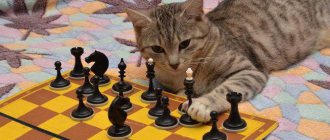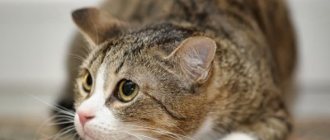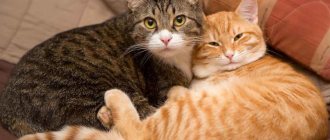If the cat ran away and went on a spree or simply got lost while the owners were moving or on vacation, there is a possibility that he will return. In order for a cat to return home, his vision, hearing and smell help him in this. There are theories from experts who believe that a cat’s memory and its ability to navigate its environment thanks to its sense of magnetic fields are of great importance.
According to experts, the more time a domestic cat spends outside, the higher its chance of finding its way home, unlike “reclusive” pets who never leave the premises.
Natural data of cats
We still don't know exactly what makes cats such skilled explorers, but they are top-notch at it. Humans have approximately 5 million odor-sensing nerve endings in the nose. Impressive, right? But not when you are a cat, because it has 19 million of these receptors. Using only scent, a cat can find a way out of many situations.
When your cat rubs against something, it's probably because she's happy or because she's giving the item her scent. The presence of scent on an object signals to other cats that the object belongs to him. This also allows the cat to recognize its own scent, so it can easily find the object in the future just by sniffing it. Leaving its scent throughout its territory, your cat can find its home by smell over short distances and not get lost.
Cats find their way home using a compass!
- And now I’m heading south-south-west!
One of the strangest and most mysterious things in nature is the ability of some animals to return to home, sometimes from the most remote places.
How do they do this?
Among pets, cats are absolute champions in orienteering. They return to their birth threshold more often than dogs and birds. Moreover, yard murks are much more capable than apartment ones. How do they do this?
Several years ago, German scientists conducted a series of experiments on the ability of cats to navigate. To begin with, the animals were placed in closed boxes and driven around the city along a confusing route. Then the animals were taken outside the city, where a large labyrinth was built with 24 exits in different directions, like the markings of a compass. The top of the maze was closed so that the cats could not see either day or night. After this, the animals were placed in the labyrinth one by one and were given the opportunity to wander around it until they chose the desired exit. In 98% of cases, the cat walked out clearly in the direction of its own home!
The experiment was duplicated by zoologists in the USA. Just to be sure, the cats were sedated with sleeping pills on the way to the maze to eliminate the possibility of “memorizing” the turns. But even in this case, most of the murks confidently chose the right direction to the house.
And scientists concluded: murkas have extraordinary sensitivity to the Earth’s magnetic field, which allows them to accurately find their way. This happens thanks to iron particles, which are part of the animal’s tissues and form a kind of internal compass.
The correctness of the conclusions was confirmed by a subsequent experiment - cats began to wander when a powerful magnet was attached to their body.
BY THE WAY
Cat records
In England, one cat returned home after running 70 km through a wooded area; the journey took 3 weeks. In Holland, a cat walked 150 km in five months, in the state of Georgia (USA) a cat that was taken 320 km away returned, and in France a record of 700 km was registered - a cat covered it in seven months.
Dogs rely on hearing and smell
Unfortunately, dogs navigate terrain worse than birds and cats. Most likely, scientists believe, too much domestication of dogs is to blame for this. A lost or abandoned dog behaves similarly to a person in the same situation: it runs back and forth confusedly, experiences fear and stress. This situation is especially true for city dogs, who are hopelessly lost literally a kilometer from home, and there is not the slightest chance for them to return to their owner on their own. Rural dogs are more independent, but also do not shine with special abilities, their limit is a distance of 10 - 15 km.
How do dogs navigate? Firstly, they are helped by an excellent sense of smell - winds carry odors over many hundreds of kilometers. Sometimes a dog’s nose picks up familiar components, and the dog “gets” on the trail. Acute hearing also helps - the operation of large objects such as power plants and factories can be heard by animals tens of kilometers away. Therefore, when dogs find a familiar smell or sound, they run in its direction, very afraid of losing it. And this is precisely what prevents them from getting home - the animals, carried away by the trail, do not notice either highways or roads.
True, it happens differently. For example, Labrador Archie lost his owner at a busy train station in the capital of Scotland and, after unsuccessful attempts to find the owner, the dog... got on the right train and got off at his stop! Police surveillance cameras recorded how the dog first rushed about in search of its owner, then went to the desired platform and entered the carriage without hesitation.
Birds navigate along major roads
Bird flight is an amazing example of the ability to find one's way. For example, there are sparrows that return every year from South Africa to England to build nests. Every year they fly ten thousand kilometers and do not go astray; they are helped in this by internal “compasses” - similar to those that cats have.
Among poultry, the leader in orienteering is, of course, pigeons. Previously, it was assumed that they were guided by the sun, moon and stars. Researchers from the University of Oxford have spent more than 10 years studying the travel patterns of pigeons using cutting-edge tools such as GPS satellite navigation systems. It turned out that birds most often fly following familiar highways, often making large loops after the highway where they could fly in a straight line. Scientists have found that it is easier for birds to fly this way than to find their way home in any other way.
Moreover, the funniest thing was that some Italian pigeons, it turns out, had learned the location of roads since ancient Roman times and still have not considered it necessary to relearn them. For example, they fly along Via Aurelia - the oldest highway, dating back to 241 BC. e. connecting Rome with Gaul and Spain, and prefer this route to the newer and larger A12 highway and railway lines.
Cat navigation
Navigation research by scientists continues, and it is possible that cats, like birds, are naturally able to detect the Earth's gravitational field. This would give them a sense of direction even without appropriate visual cues. Birds need this when flying. It is possible that cats also have this skill, but to a lesser extent than birds.
People rely on visual cues. Cats also use landmarks to navigate, although their extremely high level of spatial intelligence adds a new dimension to this ability. Cats are experts at locomotion and remembering how to move based on the position of their bodies in relation to various objects. The paths our cats take through the neighborhood can seem incredibly confusing, and yet they follow them the same way every time, weaving through the branches of that particular bush and jumping between those particular fence posts.
How do animals migrate?
Many animals use a number of sensory systems to travel long distances. Desert ants, for example, use olfactory signals to navigate their way from a food source back to their home, because odors are carried over long distances by the wind. Bees can remember routes to food locations when exposed to scents from that location. Other species, such as turtles, some amphibians, lobsters, and birds, are able to use magnetic positional information to navigate a specific area. This latter ability to use geomagnetic information is of great importance as it is not affected by weather conditions, light-dark cycles, seasonality or global position, although other signals may be affected by it.
In addition to a magnetic “compass,” birds also likely use solar and celestial “compasses” for navigation. Parasitic nematodes are able to find their way to their host by responding to seismic vibrations, and other species use vibrations to capture prey. Bats, birds and marine mammals can locate and travel using sonar and infrasound, while visual cues are critical to humans.
Juicy sandwich cake for tea: carrot sponge cake and a layer of airy cream
“The same facial expression”: Krutoy spoke about plastic surgery lovers
A neighbor made a modern, beautiful TV stand from an old chest of drawers
Magnetic attraction
The Earth is covered in magnetic fields, invisible forces that repel and attract each other depending on whether they are positively or negatively charged. Magnetic fields originate deep in the planet's core and radiate out to the surface, where they are influenced by tides and other magnetic forces from space. Every place on the planet has its own unique magnetic signature, based on the strength of the field at a given moment in time and space. We humans may need a special tool to detect this, but many animals can find magnetic north using just their mind and body. Among these animals are cats.
Many scientists believe that magnetic compounds are connected to the cat's central nervous system, which uses them to create a sixth sense: magnetoreception. Magnetic connections point toward magnetic north, but they can also detect field strength information in any direction. Magnetoception is not just a compass, it is a full-fledged GPS system. It's not known for sure whether cats can sense magnetic fields, but if they can, it might help explain why they are such skilled navigators.
Magnetoreception in animals
Interestingly, recent evidence suggests that dogs and some primates have molecules associated with magnetoreception, the ability to sense a magnetic field. This may be an additional explanation for how dogs return home.
Cryptochrome 1 is a protein molecule that regulates the circadian rhythms of many plant and fish species. But it turns out that these same molecules are present in the retinas of a number of other animal species, including dogs, foxes, wolves, bears and badgers. Cryptochrome has also been identified in several primate species, including Borneo orangutans.
Who could landowners in Rus' hire as servants and how much did they pay these people?
Children love my signature fish soufflé cupcakes with cheese (recipe)
Common care mistake: planting hydrangeas in the shade of trees
When cats can't get home
Although it is common knowledge that cats are excellent navigators, this is not true for every individual cat. Some cats have trouble simply finding their way around the house, let alone navigating the outside world. This is especially true for domestic cats. An indoor cat that gets lost will not know in advance how to return to its territory, or how to avoid the dangers that await it on its way home.
Outdoor cats tend to be much better at finding their way home due to experience. A cat that is let out for a walk is an expert in how to get home. Wildcats in particular tend to have exceptional homing skills when needed. They are truly experts at crossing their territories to find food and shelter, and any cat that cannot do this will not live long enough to continue its breed. Thus, breeding in the wild occurs between the most experienced feline trackers, who then pass on their talents and knowledge to the next generation.
A wonderful homecoming
In April of this year, the world was surprised by the story of Pero, a four-year-old working shepherd dog. Perot managed to find a way from Cockermouth in Cumbria back to his former home, which is located on the coast of Wales. This true-life story is reminiscent of the movie Lassie Comes Home. Perot was able to run about 385 km over two weeks. It is noteworthy that the microchip that was on the dog confirmed that this was not an accident, and the young shepherd had indeed found its way to its first home.
Stories like this often attract the attention of the media, whose readers puzzle over how animals can travel. Although there are rumors that the dog was simply dropped off on his native farm, such stories prove the wonderful nature of animal instincts. The friendly relationship between people and dogs becomes the reason that we want to believe in some kind of magic of this ability. The question arises: does this ability to navigate exist only because of the close bond between the dog and its owner, or is there some scientific explanation for such a phenomenon?
A building made of porous bricks was built in Iran. How it is lit inside (photo)
2 stories about children's ingenuity: my daughter was playing and the ball hit the table
Freezing Peaches: Drizzled with Lemon Juice Will Keep Peaches Longer
Unexplained Appearance
We've gradually gotten closer to what makes complete strangers show up at your door, excluding the points described above. Psychics are inclined to believe that if a cat has arrived in your house, it means that in this way the Universe is sending you a protector. Cats are famous for their amazing ability to cope even with strong negativity, the energy of which is about to harm the inhabitants of your house (apartment).
The third part of the film “Mamma MIA!” will be released.
Eaten in one sitting: prepare navy-style green beans (recipe)
Summer recipes: preparing delicious red borscht with “raw” currant jam
It is strictly forbidden to kick out an unexpected guest. By driving away the cat, you can easily scare away the protective forces that want to provide help through the appearance of a cute creature on the threshold of your home.
In addition to psychics, ordinary people have long been familiar with signs about cats and cats. In ancient times, the appearance of a strange animal in a hut, which had nestled itself to the house on its own, was considered a good sign. Our great-grandmothers and grandmothers tell us that a visiting cat, cat or their baby urgently needs to be let inside. It is also recommended to pay attention to the color of the pet and its behavior - they will indicate many important points.
Hard moments in life
What prompts a hitherto unknown animal to appear on your doorstep and visit your home in the most difficult times? Elderly people and modern psychics have an explanation for such visits.
What the son of handsome Alexander Domogarov looks like (the men are completely different)
All my friends are jealous: my husband made a bright and stylish wardrobe for his wife from the attic
I bought furniture from IKEA and made an amazing designer cabinet out of it.
Kittens clinging to you. The sign says that the poor things need to be fed and warmed. Don't forget that kittens are the babies of cats. If you are eager to have an heir, but it still doesn’t work out, by adopting a kitten (or several) into your home, you may very soon become parents. This often happens - they couldn’t have children, they took a kitten, and after a year or two the desired pregnancy occurs.
Was a cat found clinging to your front door while there was a sick person inside the apartment? With this sign, the animal shows that it urgently needs to meet with the “patient”. It has long been known that cats can alleviate the condition of the sick. They have a beneficial effect not only on the physical side of the disease, but also treat on a psychological level. The gentle purring is soothing. However, be extremely careful if there are people in the apartment who are allergic to cat hair.
If a four-legged creature shows up in your house after the death of one of its inhabitants, shelter a cat (cat or kitten). It is believed that the visit was made for a reason. Those who have gone to another world send messages and protection to their loved ones. By the way, psychologists also advise letting the foundling into the house. The pain of loss is softened in front of the fluffy, affectionate creature.
Rituals for losing a cat
When reading the plot, you must not get confused or repeat yourself. If you are not sure what you can learn, write on a piece of paper and read from it. Cannot be read from electronic devices. You need to be sure that the plot will definitely work. Faith is the main thing.
If your cat is missing, you need to go to her favorite place and read a simple spell, the words of which will be available below. The plot must be read in the morning before dawn. It is necessary that no one sees this ritual. For the words to work, you need to read while the moon is waxing. This will contribute to the return of your beloved pet.
Second rite. They take a dog or cat's sleeping place and burn it in their yard. During the burning, certain words must be read.
There are also conspiracies to make the cat recover or behave better.
You can read about them below.











